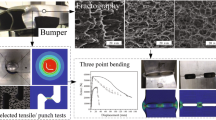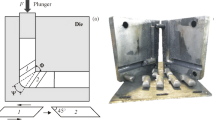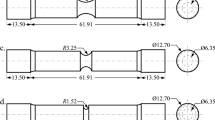Abstract
Aluminum alloy 6061-T6 (AA 6061-T6) extrusions have been widely applied in large-span reticulated shells. However, researches on behaviors of the aluminum alloy under large deformation and fracture by means of meso-mechanics are still insufficient. This paper focuses on the plastic and fracture behaviors of AA 6061-T6 extrusions over a wide range of stress states. Experiments on smooth and notched round bars, grooved plates and shear plates are conducted. It is observed that the yield stress decreases as the notch or groove radius decreases. The yield stress under plane strain or pure shear is lower than that under axisymmetric tension. In addition, true stress–true strain data obtained from tensile coupon tests overestimate the hardening behavior at large deformation. To fully describe these experimental observations, a new plastic model considering the pressure dependence, Lode angle effect, and hardening with post-necking correction is proposed. Regarding the ductile fracture, modified Mohr–Coulomb fracture model with damage-induced softening is adopted to predict crack initiation and propagation under different stress states. The material models of plasticity and fracture are numerically implemented into FE code ABAQUS/explicit by the material subroutine VUMAT. It is found that both the overall nominal stress–strain curves and fracture patterns for all specimens are well predicted by the material models. For practical engineering design, recommended reduced values of shear strength and high-triaxiality tensile strength of AA 6061-T6 extrusions are given.





















Similar content being viewed by others
References
Yang L, Wei S, Zhang Q. Aluminum reticulated spatial structures: state of the art and key issues. J Build Struct. 2013;34(2):1–19.
Beese AM, Luo M, Li Y, Bai Y, Wierzbicki T. Partially coupled anisotropic fracture model for aluminum sheets. Eng Fract Mech. 2010;77(7):1128–52.
Zhao X, Yan S, Chen Y. A review on progressive collapse study for large-span space structures. J Build Struct. 2013;34(4):1–14.
Zhu P, Zhang Q, Luo X, Ouyang Y, Yin J. Experimental and numerical studies on ductile-fracture-controlled ultimate resistance of bars in aluminum alloy gusset joints under monotonic tensile loading. Eng Struct. 2020;204:109834.
Shi M, Xiang P, Wu M. Experimental investigation on bending and shear performance of two-way aluminum alloy gusset joints. Thin Walled Struct. 2018;122:124–36.
Drucker DC, Prager W. Soil mechanics and plastic analysis or limit design. Q Appl Math. 1952;10(2):157–65.
Spitzig WA, Sober RJ, Richmond O. The effect of hydrostatic pressure on the deformation behavior of maraging and HY-80 steels and its implications for plasticity theory. Metall Trans A. 1976;7(11):1703–10.
Yoon JW, Lou Y, Yoon J, Glazoff M. Asymmetric yield function based on the stress invariants for pressure sensitive metals. Int J Plast. 2014;56:184–202.
Bai Y, Wierzbicki T. A new model of metal plasticity and fracture with pressure and Lode dependence. Int J Plast. 2008;24:1071–96.
Kang L, Ge H, Fang X. An improved ductile fracture model for structural steels considering effect of high stress triaxiality. Constr Build Mater. 2016;115:634–50.
Drucker DC. Relation of experiments to mathematical theories of plasticity. J Appl Math. 1949;16(4):349–57.
Cazacu B, Barlat F. A criterion for description of anisotropy and yield differential effects in pressure-insensitive metals. Int J Plast. 2004;20(11):2027–45.
Cazacu B, Plunkett F, Barlat F. Orthotropic yield criterion for hexagonal closed packed metals. Int J Plast. 2006;22(7):1171–94.
Gao X, Zhang T, Zhou J, Graham SM, Hayden M, Roe C. On stress-state dependent plasticity modeling: significance of the hydrostatic stress, the third invariant of stress deviator and the non-associated flow rule. Int J Plast. 2011;27(2):217–31.
Bridgman PW. Studies in large plastic flow and fracture. New York: McGraw-Hill; 1952.
Zhano K, Li Z. Numerical analysis of the stress–strain curve and fracture initiation for ductile material. Eng Fract Mech. 1994;49(2):235–41.
Ling Y. Uniaxial true stress–strain after necking. AMP J Technol. 1996;5:37–48.
Jia LJ, Kuwamura H. Ductile fracture simulation of structural steels under monotonic tension. J Struct Eng. 2014;140:1–12.
Jia LJ, Ge H, Shinohara K, Kato H. Experimental and numerical study on ductile fracture of structural steels under combined shear and tension. J Bridg Eng. 2016;21:1–18.
Bai Y, Wierzbicki T. Application of extended Mohr–Coulomb criterion to ductile fracture. Int J Fract. 2010;161:1–20.
GB/T50429. Code for Design of Aluminium Structures. China Planning Press Beijing, China; 2007.
Aretz H. A consistent plasticity theory of incompressible and hydrostatic pressure-sensitive metals. Mech Res Commun. 2007;34(4):344–351.
Stoughton TB, Yoon JW. A pressure-sensitive yield criterion under a non-associated flow rule for sheet metal forming. Int J Plast. 2004;20:705–31.
Chen H, Salip A. Elasticity and plasticity. Beijing: China Architecture & Building Press; 2004.
Simo JC, Hughes TJ. Computational inelasticity. Berlin: Springer Science & Business Media; 2006.
Drucker DC. A definition of stable inelastic material. Providence: Brown University; 1957.
Wilkins M, Streit R, Reaugh J. Cumulative-strain-damage model of ductile fracture: simulation and prediction of engineering fracture tests. Lawrence Livermore National Lab, CA (USA); Science Applications, Inc., San., 1980.
Glüge R, Bucci S. Does convexity of yield surfaces in plasticity have a physical significance? Math Mech Solids. 2018;23:1364–73.
Li Y, Wierzbicki T. Prediction of plane strain fracture of AHSS sheets with post-initiation softening. Int J Solids Struct. 2010;47:2316–27.
Acknowledgements
This work is supported by the National Natural Science Foundation of China (Grant no. 51738009) and Scientific and Innovative Action Plan of Shanghai (Grant no. 14DZ2252300).
Author information
Authors and Affiliations
Corresponding author
Ethics declarations
Conflict of interest
The authors declare that there is no conflict of interest in this work.
Additional information
Publisher’s note
Springer Nature remains neutral with regard to jurisdictional claims in published maps and institutional affiliations.
Appendix 1
Appendix 1
1.1 Actual sizes
The nominal dimensions of these five types of specimens are illustrated in Fig. 4. Their actual dimensions are listed in the following tables (in mm or mm2).
Smooth round and notched bars
Minimum diameter (D1) | Area of critical section | Diameter of clamping section (D2) | Specimen length (L) | |
|---|---|---|---|---|
SB_1 | 8.02 | 50.52 | 8.98 | 150.04 |
SB_2 | 8.02 | 50.52 | 8.98 | 149.99 |
NB150-1 | 5.95 | 27.84 | 8.96 | 150.05 |
NB150-2 | 6.03 | 28.54 | 8.96 | 150.02 |
NB15_2 | 6.01 | 28.37 | 8.98 | 150.03 |
NB6_1 | 6.03 | 28.56 | 8.99 | 150.01 |
NB6_2 | 6.07 | 28.94 | 8.98 | 150.01 |
NB3_1 | 5.98 | 28.09 | 8.99 | 150.06 |
NB3_2 | 6.02 | 28.46 | 8.98 | 149.96 |
Grooved plates
Minimum thickness (t) | Width (W) | Area of critical section | Depth of one groove (h1) | Depth of the other groove (h2) | Specimen length (L) | |
|---|---|---|---|---|---|---|
GP5_2 | 1.86 | 40.03 | 74.46 | 2.05 | 2.13 | 150.41 |
GP5_3 | 1.99 | 39.93 | 79.46 | 1.99 | 1.93 | 149.90 |
GP2_1 | 2.14 | 40.01 | 85.62 | 2.03 | 1.89 | 150.09 |
GP2_2 | 2.08 | 39.97 | 83.14 | 1.91 | 2.01 | 150.09 |
GP1_3 | 2.11 | 40.03 | 84.46 | 1.96 | 2.01 | 150.03 |
Pure-shear plates
Minimum thickness (t) | Groove length (gL) | Area of critical section | Depth of one groove (h1) | Depth of the other groove (h2) | Specimen length (L) | Width (W) | |
|---|---|---|---|---|---|---|---|
S00_1 | 2.07 | 12.32 | 25.50 | 1.85 | 2.01 | 150.11 | 79.97 |
S00_3 | 1.93 | 11.96 | 23.08 | 2.13 | 2.00 | 150.10 | 80.04 |
Dimensions in mm.
Rights and permissions
About this article
Cite this article
Zhu, P., Zhang, Q., Xu, H. et al. Experimental and numerical investigation on plasticity and fracture behaviors of aluminum alloy 6061-T6 extrusions. Archiv.Civ.Mech.Eng 21, 88 (2021). https://doi.org/10.1007/s43452-021-00225-3
Received:
Revised:
Accepted:
Published:
DOI: https://doi.org/10.1007/s43452-021-00225-3




